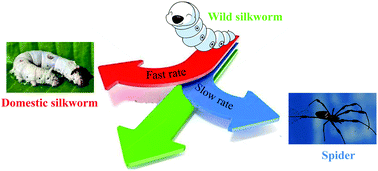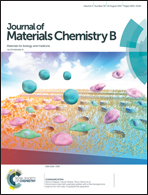Precise correlation of macroscopic mechanical properties and microscopic structures of animal silks—using Antheraea pernyi silkworm silk as an example†
Abstract
Animal silks, as one type of high performance natural material, display a unique combination of modulus, tensile strength, and extensibility that gives rise to a greater toughness than any other natural or synthetic fibers. Many previous researchers have already suggested that such excellent comprehensive mechanical properties should be closely related to their special molecular structures. In this paper, we provide more direct evidence to such an assumption by using Antheraea pernyi silkworm silk (tussah silk) as an example with synchrotron radiation FTIR microspectroscopy as a major characterization tool. Being a silkworm silk, A. pernyi silk has the same function as other silkworm silks (like common Bombyx mori silk), but on the other hand, its amino acid residue sequence is similar to that of spider dragline silk. Thus, A. pernyi silk can be a bridge between silkworm silk and spider silk that is worth investigating. Hence, in this research we designed different forcibly reeled A. pernyi silk samples by controlling the reeling rate, and subsequently tested their mechanical properties and then correlated them with their molecular structures and orientation degrees. Results show that the Young's modulus and breaking stress of forcibly reeled A. pernyi silks increased with the reeling rate, whereas the breaking strain was reduced. In the meantime, structure characterization revealed that the β-sheet content and molecular chain orientation in A. pernyi silk all increased significantly with an increase in reeling rate. In addition, the mechanical performance of A. pernyi silk can be altered from close to that of spider dragline silk to that of B. mori silkworm silk, with just a change of the reeling rate. All these phenomena clearly indicate that structural changes in A. pernyi silks contrived and controlled by reeling rate have a great effect upon their final mechanical properties. These observations further confirm that the mechanical properties of animal silks are able to be tuned by structure control during harvest time. Furthermore, the results obtained in this study may provide useful guidance when designing and producing high performance regenerated silk fibers for different applications.



 Please wait while we load your content...
Please wait while we load your content...